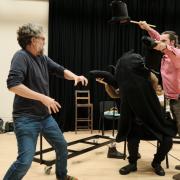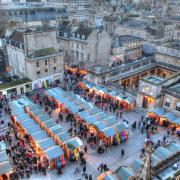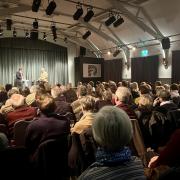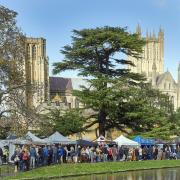WORDS: Melanie Greenwood

There are three major carnival committees – Wessex Grand Prix Circuit, South Somerset Federation of Carnivals Committee Circuit and the Somerset County Guy Fawkes Carnival Association (GFCA) all vying to be the best in the West. Beginning at the end of August in Sturminster colourful floats packed with lights, hand-made costumes and imaginative themes criss-cross the countryside until 16 November.
During that time nearly one million spectators from home and abroad watch along the way bringing in millions of pounds to the Somerset economy.
However, some believe carnivals are under severe threat with stringent road regulations put on floats that have seen clubs folding.
The Wessex Grand Prix Carnival Circuit, now in its 35th successful year, was the brainchild of Keith Berry of Frome Carnival Association and Gordon Stockman of Castle Cary Carnival Society.
Gordon said: “We originally had 70 clubs, now we are down to 43 and only a dozen floats.
“Back in the 1980s we had a code of conduct with police with regards to road safety that worked for us.
“Now we are subject to vehicle special order regulations which mean the floats become abnormal loads and bound by commercial rules.
“Where once a float would cost around £5,000 to put on the road and travel between carnivals, now it’s more than £15,000. This is decimating the number of clubs involved.
“It is a massive threat to carnivals and they may not exist in five years time yet they bring in £41million pounds to the local economy. It’s shocking.
“Carnivals are a special art form which is vital to local traditions, culture and the economy.”
The events also raise thousands of pounds for good causes as well as giving a vital financial shot in the arm for cash-strapped local communities in winter.
Vice-chairman of Glastonbury’s carnival club, Tony Frazier, has been involved for 24 years and its carnival history stretches back 130 years.
Tony said: “Glastonbury has a quirky, wonderful atmosphere and people who have never been fall in love with the Tor, the Abbey ruins and our wonderful independent shops. It’s a boon for business.
“We have six clubs building floats year round and this is our biggest annual event – the pop festival is actually at Pilton - I like to think the carnival season saves the best to last with us.
“The buzz is wonderful and just about makes up for the mountain of paper work involved the rest of the time to meet stringent regulations.”
John Lewis is secretary to South Somerset Federation of Carnivals Committee Circuit which has been touring Wellington, Illminster, Chard and Taunton since 1966.
This year around 30,000 spectators are expected to pour into Taunton on 19 October to watch the 85 floats and marchers through the streets.
John said: “We have 20 clubs making floats and during the day there is a vintage rally of cars and motorbikes which are more than 75 years old.
“I enjoy organising the whole wonderful event and it’s fantastic for our local economy in each town.”
Bridgwater Guy Fawkes Carnival Association (GFCA) sets off on 2 November at 7pm with a dazzling display of floats that marks the failure of the infamous gunpowder plot.
The GFCA covers a ‘Magnificent Seven’ communities of Burnham, Wells; Shepton Mallet, North Petherton, Glastonbury and Weston-super-Mare.
Around 300,000 visitors from the UK and abroad are set to give a vital financial shot in the arm to the region in what has become a global phenomenon each autumn.
Chris Hocking, author of Remember Remember: The Story of Bridgwater Carnival and President of Bridgwater Carnival Committee has had hands-on involvement since 1967.
From his Carnival HQ in the High Street next to the Town Hall, he said: “The first official carnival here was in 1881 but it began with bonfires in 1605 after the failed Catholic gunpowder plot.
“Bridgwater was a mainly Protestant town and begun the event which has expanded hugely. I’m looking at a poster highlighting the 1899 event, which included a re-enactment of the Boer War, so it’s a flexible commemoration.
“Now we have a team coming from Rio de Janeiro in Brazil riding on carts that can cost up to £20,000 to decorate. “Annual designs are shrouded in mystery; unique and fresh every year, although we recycle as much as we can.”
It wasn’t always so flashy. The original event consisted of a bonfire at the Cornhill built in a large wooden boat filled with barrels of sticky pungent tar and anything else flammable.
Guy Fawkes effigies were walked around and thrown on top of the pyre and so the trend towards a procession gradually started.
The grand finale was – and still is - ‘Squibbing’.
Originally, a squib was a firework held precariously aloft by around 100 people or ‘squibbers’ who stood in a long line along the High Street. The event culminated with a large bang as each squib was extinguished.
Health and Safety coupled with costly insurance now means slightly more of a damp squib affair. Nevertheless, 170 fireworks are lit simultaneously at around 11pm to provide a spectacular end to a day of fun that starts at 10am.
The Bridgwater Carnival took on a semblance of today’s procession in 1881 although it must have been a softly lit show by oil lamps as electric lights were only introduced in 1913.
During World War II, with the lethal threat of German bombs dropping, all lights were extinguished, but a few walkers still gingerly led the way in darkness to keep the tradition alive.
Now around 2,000 people take part who are known as Masqueraders.
Another 2,000 work behind the scenes fundraising for the event and raising cash for good causes
The floats or ‘carts’ have transformed over time into elaborate trailers up to a maximum of 100 foot long. They are furtively built by local clubs of individuals who self-fund with charitable donations and business sponsorship.
Driven by highly-decorated tractors, the carts usually include a diesel-driven electric generator providing the vast amounts of energy required for up to 30,000 lamps around displays.
Floats chug along at a snail’s-pace interspersed with walking exhibits of groups or singles, marching bands, majorette troupes, and charity collectors.
Float themes have included children’s books such as Alice in Wonderland, Disney characters, pre-history, future space, fierce English battles, Ghost Ships – anything the imagination comes up with.
And it’s all undertaken in a frenzy of close-guarded secrecy and super-competitiveness. Nobody wants to share their ideas; they want a huge surprise on the night.
Thirteen local groups meet weekly and they are joined by teams from as far as Devon and Dorset, all trying to outdo one another.
Chris added: “There is intense rivalry but it’s all friendly.
“Next year’s undercover preparations begin as soon as this year’s carnival ends. It’s fantastic for local communities.”
Individual clubs raise money for the floats holding a host of fundraising activities to special carnival concerts.
Carnival concerts take place leading up to the Bridgewater event and are a chance for clubs to perform on stage wearing costumes and using pieces of their scenery.
The youngest participant was just three and the oldest over 75.
While the carnival procession rolls into action in the evening, the fun usually begins early daytimes with music, performances and a host of fun events to get everyone in a festival mood.
Chris said: “In the Past 46 years I’ve seen so many outstanding floats; it’s amazing how creative people are.”
Perhaps the perennial question will be as spectators pack woollies and waterproofs: ‘What about the weather?’
Chris joked: “Warm and sunny of course! That’s what we tell everyone. Last year it happened to be very cold and dry, so wrap up and enjoy a mulled wine.”
Carnival Dates for 2013
Wessex Grand Prix Circuit
12 October 7.30pm Castle Cary
19 October 7pm Trowbridge
26 October 7pm Warminster
South Somerset Federation of Carnivals Committee Circuit
12 October 7.15pm Chard
19 October 7pm Taunton
Somerset County Guy Fawkes Carnival Association (GFCA)
2 November 7pm Bridgwater
4 November 4th 7pm Burnham-on-Sea
8 November 7.15pm Weston-super-Mare
9 November 7pm North Petherton
13 November 7pm Shepton Mallet
15 November 7pm Wells
16 November 7pm Glastonbury
Gunpowder Plot:
While some carnivals celebrate the return of soldiers from World War I as in Castle Carey, the Bridgwater Carnival celebrates the failure of the Gunpowder Plot.
In 1603 Queen Elizabeth I was dying. Her likely successor was James VI of Scotland, the son of Mary Queen of Scots - who had been executed in 1587 on Elizabeth’s orders.
English Catholics were delighted, James’ wife was a Catholic and they hoped that the years of persecution they’d suffered since 1570, when the Pope had excommunicated Elizabeth would be over. But by early 1604 James publicly renounced Catholics and backed Puritans.
The Gunpowder Plot of 1605 was a failed assassination attempt against King James I of England and VI of Scotland by a group of English Catholics led by devout Catholic Robert Catesby.
It planned to blow up the House of Lords during the State Opening of England’s Parliament on 5 November 1605, as a prelude to a popular revolt during which James’s nine-year-old daughter, Princess Elizabeth, was to be installed as the Catholic head of state.
His fellow plotters were John Wright, Thomas Wintour, Thomas Percy, Guy Fawkes, Robert Keyes, Thomas Bates, Robert Wintour, Christopher Wright, John Grant, Ambrose Rookwood, Sir Everard Digby and Francis Tresham.
Fawkes, who had a decade of military fighting under his belt suppressing the Dutch Revolt in the Netherlands, took charge of the explosives.
But an anonymous letter sent to William Parker, Lord Monteagle, on 26 October 1605 revealed the plot. During a search of the House of Lords late on November 4th 1605, Fawkes was discovered with 36 barrels of gunpowder and arrested. Most conspirators fled. At their trial on January 27th 1606, eight survivors, including Fawkes, were convicted and sentenced to be hung, drawn and quartered.
Anti-Catholic legislation was introduced after the plot’s discovery which evolved into Bonfire Night. But ordinary Catholics suffered with laws passed preventing them from practising law, serving in the army and navy or voting. The latter law wasn’t lifted until 1829.



























